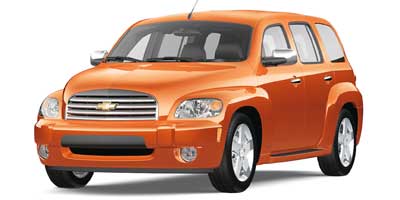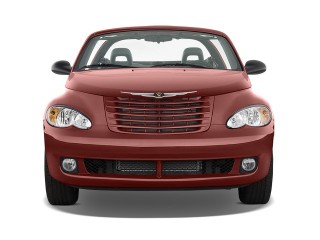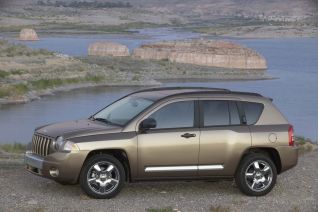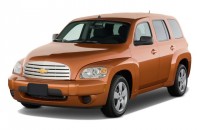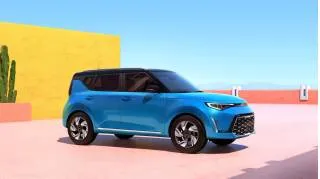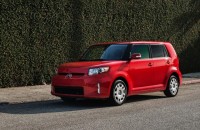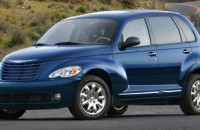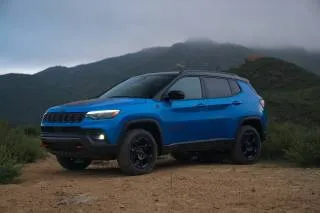Likes
- Spacious interior
- Upright seating
- Strong performance from new HHR Panel SS
Dislikes
- Small gauges
- Four-speed automatic transmissions
- Lack of headroom
- Power window switch placement
Buying tip
features & specs
The 2009 Chevrolet HHR is a great urban runabout for small-business owners with frequent cargo hauls.
The 2009 Chevrolet HHR (the name stands for "Heritage High Roof") shares its basic architecture with the Chevy Cobalt (available in coupe and sedan body styles). Despite the HHR’s inauspicious foundation, this tall-roofed crossover is a well-orchestrated machine that provides cargo-carrying utility and spirited performance.
Standard-duty versions of the 2009 Chevrolet HHR can be powered by one of two four-cylinder engines: a 2.2-liter or 2.4-liter. Both engines power the front wheels via either a standard five-speed manual transmission or optional four-speed automatic; a remote start feature is offered with the 2.4-liter. For 2009, variable valve timing has been added to the base 2.2-liter Ecotec engine, which increases horsepower to 155, up from the ‘08's powerplant rating of 149 horses. Since the new engine is more efficient, fuel economy is improved, yielding a driving range of up to 500 miles between petrol pit stops. With either transmission, though, performance is just adequate, and the HHR’s powertrains feel somewhat less refined than that of rival vehicles.
High-performance-minded drivers that don’t want to sacrifice excellent fuel economy now have another 2009 Chevrolet HHR SS model to satiate their need for efficient speed: the HHR Panel SS model. Unlike some recent Chevys with "SS" decals but no guts, the HHR SS and Panel SS have big muscles. Driver-selectable performance features including the “no-lift shift” help the SS achieve 0-60 mph performance in 6.3 seconds and cover the quarter-mile in 14.8 seconds at 98.5 mph. Equipped with the manual transmission, the SS has a top speed of more than 150 mph. Powering the SS models—which are the most desirable of the HHR lineup, in the opinion of TheCarConnection.com—is a turbocharged and direct-injected 2.0-liter Ecotec engine, which enables the HHR SS to achieve EPA-rated highway mileage of 29 mpg with the manual transmission and 28 mpg with the automatic.
A sport suspension is included on the Chevy HHR LT model for more responsive handling, though it doesn’t make a tremendous difference. All of the non-SS versions have a quite soft, absorbent ride and handling that’s responsive though not sporty.
Packaging is hit-and-miss in the 2009 Chevrolet HHR. The front seats can be a bit cramped, headroom is especially tight, and the second row isn’t tremendously roomy either. But fold down the second row and the HHR hauls an amazing amount of cargo. A flexible cargo management system includes flat-folding rear and front passenger seatbacks, various storage bins, and a height-adjustable cargo panel. Cargo carrying is after all the HHR's forte, and the LT Panel version, intended for use as a nimble cargo delivery vehicle, maximizes that capability.
The HHR had been a little lacking in the safety-features department, but newly standard on all models for 2009 are StabiliTrak stability control, ABS, tire pressure monitoring, roof rail airbags, and OnStar.
Providing hands-free calling and wireless play for audio devices through the radio, a Bluetooth interface for the phone is now standard on the 2009 Chevrolet HHR. A rear backup camera is available as an option. The 2LT comes equipped with new 17-inch ChromeTech wheels.
2009 Chevrolet HHR Styling
Whether the retro styling does it for you or not, the HHR’s design is different—and quite functional.
The 2009 Chevrolet HHR pairs fashionably retro styling with a shape that helps get the most out of very compact dimensions.
Edmunds calls the Chevrolet HHR, which Chevrolet has said was inspired by the 1949 Suburban, "a modern take on the expressive, big-fendered American vehicles of the late 1940s.”
That said, the styling on the 2009 Chevy HHR garners a mixed reception from reviewers. Car and Driver likes its “pleasing exterior curves,” and the Detroit News gives good marks to its “playful retro design inside and out.” However, the News and many other outlets point out that the more recent HHR “looks like such a blatant copy” of the Chrysler PT Cruiser.
A special HHR SS version, which—most notably from a styling standpoint—has larger wheels and flashier rims that give the HHR a different sense of proportion, first appeared in ’08 and is now joined by an HHR Panel SS. They both receive some sweet design cues to highlight the cars high-performance drivetrain. Autoblog says that there are "some changes with the Chevrolet HHR SS, but the car is still instantly recognizable as a Heritage High Roof." Cars.com says "the [Chevrolet] HHR SS is a stylish one from many angles...helping its cause are a number of SS-specific cues, like a black mesh grille that replaces the horizontal silver bars on regular Chevrolet HHRs."
Those hoping for the retro themes to continue inside might be a little disappointed; the HHR’s instrument panel and appointments are styled like other vehicles in the GM stable. "[T]he Chevrolet HHR features thoroughly modern interior styling...tasteful chrome rings and accents combine with pleasing buttons and knobs in a contemporary interior that looks and feels like nothing from the automaker's past," declares Kelley Blue Book, while Edmunds notes the “handsome bright-ringed gauges" and calls the interior “attractive and functional.” Automobile Magazine highlights the “nice, suede-like inserts on the seats."
2009 Chevrolet HHR Performance
The SS versions have a much stronger, go-fast character to satisfy enthusiasts, but if you don’t need pulse-raising performance, the standard versions of the 2009 Chevrolet HHR are just fine.
A wide range of reviews surveyed by TheCarConnection.com indicates that while performance from the sporty 2009 Chevrolet HHR SS might be quite satisfying, performance from standard versions of the HHR is only adequate—albeit economical.
The standard engine in the 2009 Chevrolet HHR receives variable valve timing in the 2.2-liter inline-four Ecotec engine, which bumps horsepower from 149 horsepower to 155 and improves fuel efficiency. The 2.4-liter version nets 172 horses and is available on higher trim levels. Both of these powerplants are E85 Flex Fuel compatible. Neither inspires confidence in passing or merging—or in stoplight drag races—according to the reviews read by or in the experience of TheCarConnection.com editors.
Although most reviewers have some gripes about the available power from either base four-cylinder engines, Edmunds calls the 2.4-liter engine “a worthwhile upgrade.” ConsumerGuide reports that Chevrolet HHR "2.4-liter models have decent around-town go, but highway passing and hill climbs can feel labored," adding that the "automatic transmission is responsive [and] quick to downshift." But the message is clear through reviews that the 2.4-liter versions still don't feel perky or particularly smooth. “The Chevy's powertrain was unable to inspire much confidence, especially during merging and passing,” says the Detroit News, and Edmunds refers to the “lack of low-end pull and refinement from the 2.4-liter engine.”
With either engine choice, the HHR is front-wheel drive and comes with a five-speed manual gearbox or an optional four-speed automatic. Edmunds underscores that the HHR lacks an all-wheel-drive option “for enhanced foul-weather capability.”
The aforementioned 2009 Chevrolet HHR SS and the new Panel SS, however, are hits with the automotive press. This version offers “spirited performance,” Edmunds says; its turbocharged 2.0-liter Ecotec four-cylinder makes 260 horsepower channeled to the front wheels through a five-speed manual transmission. Autoblog reports the SS has the same engine as “the Solstice GXP and Saturn Sky Redline," and that the "HHR packs an impressive 130 horsepower per liter," and Cars.com declares that the turbo engine “pulls the HHR SS with satisfying strength."
Autoblog notes that "the automatic loses out on power by a few dozen horses and offers a more sedate driving experience"—a pretty significant penalty for those who don’t want to do the shifting themselves—and recommends that you "stick to the manual so you don't miss out on the awesomeness that is the launch control and no-lift shifting." Apparently, the SS gets a slicker manual gearbox, which is another incentive; ConsumerGuide reports it "has smooth shift and clutch action, unlike other manual HHRs, which suffer from long throws and crude movement."
The Chevrolet HHR 2009 is frugal with fuel. Autoblog recommends that one should "hold off the throttle pedal a bit and you'll be able to get near 30 miles per gallon on the highway, according to the EPA." EPA estimates range up to a rated 30 mpg highway, with the 2.2-liter engine and manual transmission. ConsumerGuide notes that "Chevrolet recommends premium-grade gas for SS and 2.4-liter models, regular otherwise."
If you expect to hustle the HHR along twisty roads on a regular basis, you probably should cross off all trims except the SS. The HHR has “rubbery steering, bobby suspension, and imprecise control,” says Car and Driver, though it notes a “smooth ride.” ConsumerGuide considers the Chevrolet HHR "composed overall, though the ride can get bouncy over sharp bumps," and Edmunds advises that "it's best to maintain an easygoing pace, as the suspension and steering just can't keep up with overly aggressive driving... the electric-assisted steering is slow to respond and numb in feel, [and] the HHR exhibits a loss of straight-line stability during maximum braking."
Several sources have positive things to say regarding the way the SS handles. The SS version is a different beast entirely; it has “stronger braking and buttoned-down handling,” Edmunds says. Autoblog takes the HHR out on the track and raves, “We flung the little SS around with no mercy and were quite impressed by how rewarding driving the tall wagon proved to be.”
2009 Chevrolet HHR Comfort & Quality
Don’t look for luxury here; the HHR lacks refinement and seating is somewhat compromised.
Passenger comforts—and overall refinement—are a little lacking in the 2009 Chevrolet HHR, but it makes up for this deficit with cargo and storage space that’s leagues ahead of many other vehicles its size.
Reviewers almost unanimously criticize the passenger comfort afforded in the Chevrolet HHR. Edmunds says that Chevrolet HHR "standard cloth buckets are not as comfortable as we'd like, but the optional leather seats are better cushioned and more supportive," while Cars.com's editors "wish [that] the HHR had a telescoping steering column so [one] could pull the wheel closer," adding "backseat comfort is only marginal...bench seat's bottom and backrest cushions are hard and the space is legroom-challenged." Car and Driver, conversely, praises the HHR’s “sofa-like rear seat.” Automobile Magazine gripes that the HHR, obviously on a tight budget, comes with non-matching seats: "only the driver gets the more supportive, sport bucket seat (the non-matching, standard-style passenger seat preserves the fold-flat function)."
Storage and cargo capacity are where the 2009 Chevrolet HHR really shines, though. Edmunds comments that "maximum cargo capacity is among the class leaders at 63 cubic feet," and Cars.com says, "Considering its small exterior size, the HHR SS can swallow quite a bit of cargo." ConsumerGuide reports "versatile storage space," remarking "it's easy to fold the 60/40 split rear seatbacks to create a flat load floor, but front seatbacks must be far forward for headrests to clear”—a packaging blunder that can leave little legroom in front for tall drivers.
The Chevrolet HHR fares better inside than some compact cars but certainly won’t be lauded for its interior quality. "Most surfaces are textured enough to where they don't look especially cheap. SS models have slightly sportier trim that neither enhances nor detracts from the overall ambiance," according to Cars.com. On the other hand, Edmunds notes that "window buttons are awkwardly mounted behind the shifter, and some of the interior plastics are of mediocre quality." Edmunds is the most positive, saying, “Interior quality is among the best we've seen from General Motors, although it remains short of the caliber found in competing import vehicles.”
On-the-road refinement isn’t anything to praise either in the 2009 Chevrolet HHR. According to ConsumerGuide: "wind rush is well controlled, but engine buzz intrudes during acceleration. The turbo 4-cylinder whines, even under light throttle conditions. All [Chevrolet HHR] models suffer from noticeable coarse-surface tire thrum."
2009 Chevrolet HHR Safety
The 2009 Chevrolet HHR has very good crash-test scores and a full roster of airbags, making it one of the safest vehicles with such compact dimensions.
The 2009 Chevrolet HHR now comes with a generous list of standard equipment and has better-than-average crash-test scores to match.
Though crash tests weren’t run specifically on the 2009 Chevrolet HHR, the model has changed little since last tested and earned five stars for impact protection from the National Highway Traffic Safety Administration. The Insurance Institute for Highway Safety (IIHS) did not run the Chevrolet HHR through its own crash tests.
Stability control and OnStar are now standard on all Chevy HHRs, Edmunds reports, while higher trim levels offer more options: "traction control is included with ABS when ordered with an automatic transmission, and is standard on all 2LT vehicles, as is this year's new addition of stability control."
According to Cars.com, "standard SS safety features include antilock brakes and an electronic stability system.” In addition, side curtain airbags are offered on all HHR models as standard for 2009.
Proper visibility is an often neglected aspect of safety, and some reviewers disagree with respect to this on the Chevrolet HHR. While Edmunds commends the "impressive outward visibility for the regular wagon models," Cars.com says "something HHR drivers battle that isn't an issue in many other cars is forward visibility. This wagon's unique shape dictates a relatively short windshield, which in turn leads to windshield pillars—which are wide to begin with—that get in the way when checking for cross traffic or pedestrians." This source does note that Chevrolet HHR "rear- and over-shoulder visibility, however, is good."
The panel-wagon version, which omits rear side windows, has terrible rearward visibility and is intended as a work vehicle.
2009 Chevrolet HHR Features
The 2009 Chevrolet HHR offers a wide range of features for such an affordable vehicle, but it still lacks a navigation-system option.
The 2009 Chevrolet HHR LT—and especially the base LS—comes fairly stripped down, while SS editions have a longer list of features. All models now come standard with Bluetooth connectivity, allowing hands-free calling and wireless connection of audio devices to be played through the radio.
Edmunds reports that "the regular [Chevrolet HHR] wagon comes in two main trim levels: LS and LT." ConsumerGuide says Chevrolet HHR "features availability are competitive."
According to Kelley Blue Book, the Chevrolet HHR base trim includes "five-speed manual transmission, air conditioning, AM/FM/CD sound system with auxiliary input jack, power windows/locks/mirrors, remote keyless entry, cruise control, 16-inch wheel covers, trip computer [and] OnStar." They single out a "front-mounted auxiliary input jack [that] makes it easy to connect any MP3 player or other audio source to the HHR's sound system" as one of their favorites. Among the features available as upgrades are “leather seating, heated front seats, power driver's seat, stiffer suspension, power moonroof, 260-watt sound system with subwoofer, in-dash six-disc changer, MP3 compatibility [and] XM Satellite Radio."
Edmunds reports "major options for the LT include remote vehicle starting (included with the 2008 Chevrolet HHR automatic transmission), leather seating with heated front seats, in-dash CD changer, satellite radio and a sunroof."
